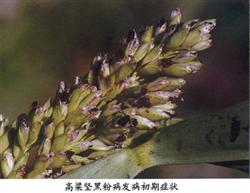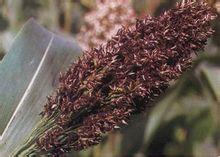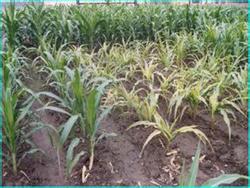Head smut of sorghum

Symptomatic diseased plants are shorter than healthy ones. At the initial stage of the disease, the ear bud of the diseased ear is very tight, the lower part is dilated, the flag leaf is straight, and the endophytic white rod can be seen, that is, Wumi. The black rice in the bracts is small at the beginning, finger-like, gradually growing, and the middle part of the posterior part is expanded into a cylindrical, harder. In the process of development, the internal tissue of Wumi changed from white to black, and then cracked, Wumi extended from the inside and outside of the bracts, and the white membrane covered with the surface also burst, revealing black filamentous figure and black powder, that is, the remaining inflorescence vascular bundle tissue and pathogenic teliospores. The leaves infected with the disease formed red-purple stripes on the leaves, which expanded and showed long fusiform stripes. In the later stage, the middle of the stripes broke, and black spores were produced on the disease spots, and the number of spores was small. The disease is common and serious in Liaoning, Jilin and Shanxi. Pathogen Sphacelotheca reiliana (Ktllln.) Clint. Synonym Sorosporium reiliaum (Ktlhn.) Mc.Alp. It is called sorghum smut fungus, which belongs to basidiomycete subphylum fungi. The teliospores are globose to ovoid, dark brown, with small spines on the wall surface, and the size is 10 Mel 15 × 9 Mel 13 (um). At the initial stage, more than 30 teliospores often gather together, and then form spherical to irregular spore clusters, the size of which is 50-70um, but they are dense and disperse after maturity. There is a film composed of hyphae outside the spore pile, and then the teliospores break out. Winter spores need physiological post-ripening before they can germinate. The germination rate was significantly increased when the spores were treated under the condition of 32ml / 35 ℃ and moist for 30 days. The bacteria can grow on artificial medium. The route of transmission and the conditions of onset of the disease are mainly carried by seeds. The bacteria scattered in the soil can survive for 1 year, and the winter spores can survive for 3 years in the deep soil. Winter spores scattered in soil or manure are the main sources of infection. After teliospore germination, binuclear hyphae invaded the young buds of sorghum, and the most suitable infection period was from seed germination to bud growth 1.5cm. The invaded hyphae initially entered the lower tissue of the growth cone, entered the interior after 40 days, and entered the differentiated flower buds after 60 days. The disease is a disease of seedling system infection. There are two host-specific types of pathogens: sorghum and corn. Sorghum specialized type mainly infects sorghum, although it can infect corn, but the incidence is not high. Corn specialization only infects corn, not sorghum. Three physiological races have been found in China. Soil temperature and water content are closely related to the disease. The incidence of soil temperature 28 ℃ and soil water content 15% is high. When sowing in spring, when the soil temperature is too low or the soil cover is too thick, the seedlings are slowly unearthed and prone to disease. The disease is serious in continuous cropping. Control methods (1) at present, the varieties resistant to head smut are Heiza 34, Hiza 46, Qiza 1, Jinza 5, Xinza 5, Xinza 7, Jiza 1, Liaoza 4, Liaozza 2 and so on. The resistant parents are Heilong 14A, 7152A, Jinong 105A and so on. (2) the rotation of large area and other crops for more than 3 years can effectively control the occurrence of the disease, and it is an economical and effective agricultural control measure. (3) Deep sterilization in autumn can reduce the source of bacteria and reduce the incidence of disease in the next year. (4) seed treatment ① soaking seeds in warm water. Soaking the seeds in 45 Mel 55 ℃ warm water for 5 minutes and then sowing the seeds immediately after germination can not only protect the seedlings but also reduce the incidence of disease. Seed dressing with ② medicament. 2g of 25% triadimefon wettable powder mixed with 1kg sorghum seeds has excellent control effect. 5kg seeds can also be mixed with 50% verapamil powder 358 and sown after seed dressing. (5) sowing seeds at the right time should not be premature. Improve the sowing quality, make the seedlings unearthed as soon as possible, and reduce the chance of germs invading from the buds. (6) to remove the diseased ear, it is required that the ash bag be buried or burned before the ash bag is broken.
- Prev

Occurrence and control of head smut in sorghum
Due to the continuous expansion of sorghum planting area and the extension of planting years, the harm of head smut of sorghum is becoming more and more serious, which directly affects the production and development of sorghum. First, the damage degree of sorghum head smut only occurred sporadically in the local area of the county in the early 1990 s, and the area of sorghum head smut in individual villages and towns was about 43 m in 2000.
- Next

Sorghum downy mildew
Sorghum seedling blight-symptom sorghum can occur when it grows to 4-5 leaves. It begins with the lower leaf and expands upward. The infected leaves produce purplish red stripes and gradually unite, causing the leaves to die gradually from the top and the seeds turn brown. Sorghum seedling blight-pathogen. Fusarium oxysporum, which is called Fusarium moniliforme, is a subphylum fungus. In PDA medium.
Related
- The first cup of black tea in spring, the flavor and history of tea gardens in Kenya, Africa
- The computer can not only choose potatoes, but also grow tea rice. AI will grow winter oolong tea champion.
- It is not only the inflated tea bitten by insects, but also engraved with the four seasons tea in Beipu.
- The Oriental Beauty Tea Festival in Zhuxian County takes the stage at the weekend to experience the plus-size feast of oil tea.
- & quot; Oriental Beauty Tea & Exploration of Emei in Hsinchu, the hometown of quot;
- The new variety of strawberry "Tainong 1" dessert is the first choice with mellow aroma. Crimson gorgeous
- History of Tea in Taiwan: from Wild Inner Mountain to Export Tea Garden
- Two types of Taiwan Oriental Beauty Black Tea won the British three-Star Award for Childhood Tea Xiang Zhang Jiaqi changed from pilot to champion tea maker.
- Banana species and varieties: the planting history of Taiwan Xianren banana and dwarf banana is long, is banana disease resistant?
- Coffee planting Technology: Qianjie Coffee from Seedling to harvesting

